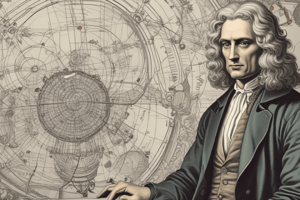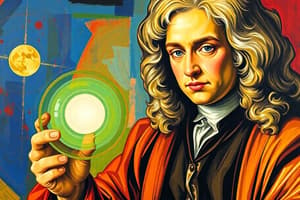Podcast
Questions and Answers
Which figure's work most directly connects advancements in medicine with the integration of chemistry?
Which figure's work most directly connects advancements in medicine with the integration of chemistry?
- Antonie van Leeuwenhoek
- Andreas Vesalius
- Nicolaus Copernicus
- Paracelsus (correct)
Which of the following best characterizes the shift in perspective that occurred during the Scientific Revolution?
Which of the following best characterizes the shift in perspective that occurred during the Scientific Revolution?
- From a qualitative, finite cosmos to a quantitative, infinite universe. (correct)
- From geocentrism to a focus on Earth as the center of the cosmos.
- From philosophical inquiry to purely experimental observation.
- From a focus on applied sciences to theoretical mathematics.
How did the heliocentric model, championed by Nicolaus Copernicus, influence the progression of scientific thought?
How did the heliocentric model, championed by Nicolaus Copernicus, influence the progression of scientific thought?
- It solidified the geocentric model, improving its mathematical accuracy.
- It laid the groundwork for modern astronomy and challenged established cosmological views. (correct)
- It reinforced the ideas presented in Ptolemy's Geocentric model.
- It primarily impacted advancements in medicine, with little effect on astronomy.
Which of the following scientists is best known for his contributions to both mathematics and philosophy?
Which of the following scientists is best known for his contributions to both mathematics and philosophy?
What technological advancement from the late 20th century most significantly enhanced the speed and capacity of internet connections?
What technological advancement from the late 20th century most significantly enhanced the speed and capacity of internet connections?
How did the work of Andreas Vesalius contribute to the progression of medical science during the Scientific Revolution?
How did the work of Andreas Vesalius contribute to the progression of medical science during the Scientific Revolution?
What distinguishes the 'Information Age' from previous eras in terms of societal characteristics?
What distinguishes the 'Information Age' from previous eras in terms of societal characteristics?
Which of the following scenarios best illustrates the application of 'Indigenous Science' in a practical context?
Which of the following scenarios best illustrates the application of 'Indigenous Science' in a practical context?
Flashcards
Scientific Revolution
Scientific Revolution
Shift from a finite, qualitative cosmos to an infinite, quantitative universe.
Heliocentric model
Heliocentric model
The theory that the sun is the center of the solar system.
Francis Bacon
Francis Bacon
An English philosopher who revolutionized scientific methodology.
Paracelsus
Paracelsus
Signup and view all the flashcards
Antonie van Leeuwenhoek
Antonie van Leeuwenhoek
Signup and view all the flashcards
Nicolaus Copernicus
Nicolaus Copernicus
Signup and view all the flashcards
Server
Server
Signup and view all the flashcards
Fiber-optic cables
Fiber-optic cables
Signup and view all the flashcards
Study Notes
- Isaac Newton was born in 1643.
- In 1661, Isaac Newton entered Trinity College, Cambridge.
- Isaac Newton died in 1727 and was buried in Westminster Abbey.
- The 16th and 17th centuries laid down the beginnings of the Scientific Revolution.
- The Scientific Revolution began in Italy and England.
- Francis Bacon was an English philosopher and statesman who revolutionized scientific methodology.
- The Copernican Revolution marks the advancement in theories about planetary orbits and their motions.
- Galileo Galilei (1564-1642) is greatly associated with the Galilean Era or the Scientific Revolution.
- The Scientific Revolution marked the shift from a finite, qualitative cosmos to the view of an infinite, quantitative universe.
- Paracelsus was a German-Swiss physician and alchemist who revolutionized medicine by integrating chemistry into medical treatments.
- René Descartes is a scientific thinker, modern philosopher, and metaphysician.
- Antonie van Leeuwenhoek is a Dutch scientist, commonly known as the "Father of Microbiology".
- The Heliocentric model replaced Ptolemy's Geocentric model, marking the beginning of modern astronomy and the scientific revolution.
- Andreas Vesalius contributed to modern medicine and anatomy by creating the first human skeleton.
- Nicolaus Copernicus, a Polish mathematician and astronomer, was a renaissance man known for his groundbreaking work on heliocentrism.
- Indigenous Science has played a significant role in shaping the county's development of Science.
- The Information Age is highly modernized, automated, data-driven, and technologically advanced.
- James R. Messenger is considered the Father of the Information Age.
- James R. Messenger first articulated his concept of the Information Age in 1982.
- A server is a computer that has been improved to provide network services to other computers.
- Laptops are portable computers that integrate the essentials of a desktop computer in a battery-powered package, somewhat larger than a typical hardcover book, and are commonly called notebooks.
- Philo Farnsworth is considered the father of television.
- Fiber-optic cables and faster microprocessors significantly improved internet speed.
- Examples of useful and reliable web resources include Google Scholar, government websites, and Google Books.
- It is important to verify web sources to avoid misinformation.
Studying That Suits You
Use AI to generate personalized quizzes and flashcards to suit your learning preferences.
Description
Explore key figures and advancements of the Scientific Revolution during the 16th and 17th centuries. Learn about Isaac Newton's life, Francis Bacon's methodology, and Galileo Galilei's contributions. Understand the shift from a qualitative to a quantitative universe.




